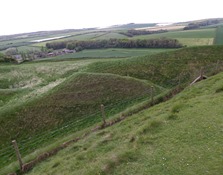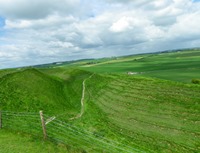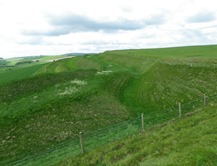
As we go about our daily lives, hurrying and scurrying, hither and thither, it is often the case that we rarely pause to reflect on surroundings we pass, or even give the location a second thought or glance. Ilchester in Somerset is one such place close to my home where most people are passing through but rarely going to.
Despite this frequently unnoticed environment, Ilchester has a long and sometimes nefarious history stretching back to Roman times and before. There does not appear to be any real definition that determines when a large village is considered to be a town or vice versa. I suspect definitions of a town have changed over time and what once was considered a large settlement in the past, would nowadays be considered small. Ilchester was once called a town, at one time, it was even the county town of Somerset before that honour moved to Taunton.

Ilchester Oppidum
Recent archaeological excavations at Ilchester’s sports field uncovered a late Stone-Age Oppidum, (a Tribal Meeting Area), in the form of a circular mound creating an enclosure. This symbolic mound was constructed of earth/clay over a base of stone. One half of the Oppidum was constructed of white Lias stone and the remainder of Ham stone.
With the Roman occupation of Britain, they established a large settlement at Ilchester about 60AD which they named Lendiniae later referred to in the seventh century as Lindinis. The settlement sat astride and protected the Fosse Way, a major route across England that linked the Roman towns of Exeter (Isca Dumnoniorum) with Lincoln (Lindum Colonia). A fork in the road at Ilchester went directly to another Roman settlement at Maiden Castle near Dorchester in Dorset. The Romans eventually made Dorchester (Durnovaria) their main settlement and many Roman relics are still found in the area today. These roads are known today as the A37 and A303.
The Romans undertook extensive engineering works to the River Yeo that flows through Ilchester to allow navigation from the sea at Burnham. Roads were also paved, drainage installed and large villas with mosaic floors and central heating were built. One of the countries largest Roman cemeteries is also located in Ilchester. Even to this day there is a requirement for much of the land covered by the old Roman settlement, for archaeologists and historians to inspect sites prior to building works.
After the withdrawal of its legions and the demise of the Roman Empire, this country entered the period known as the Dark Ages between 400AD – 900AD. This period of our history is so named as little is known about it. The Dark Ages were a period where little documentation was used or survived and much of our evidence from this time period comes from archaeological excavations. The same is true of Ilchester’s history during this time.
The Dark Ages gave way to the Middle Ages with constant Viking raids. The Vikings also established their own settlements not too far away in Dorset. King Alfred (the Great), ruled at this time and he utilised towns like Ilchester which still had surviving fortified Roman walls in his campaigns to rid the large area of England known as Wessex of the Viking invaders. The old Roman walls were so strong, that Ilchester was one of the few places able to withstand a later historical siege from William the Conqueror.
Roger Bacon the philosopher and scientist is believed to have been born here about circa 1210. As a county town, Ilchester at one time had its own mint and the county gaol. Ilchester Gaol was infamous for its ill-treatment of prisoners and public executions. It was also part of the judicial circuit of the infamous Judge Jeffreys otherwise known as ‘The Hanging Judge’. In the aftermath of the Monmouth Rebellion where West Country rebels tried to overthrow King James II, court hearings were held headed by Judge Jeffreys that became known as the Bloody Assizes. This draconian judiciary toured the West of England dispensing terminal justice to many captured rebels. Twelve of them were publicly executed at Ilchester Gaol.
Illustrations exist of regular public executions held at Ilchester Gaol which depict a gallows consisting of a long wooden beam supported by upright posts and set above the entrance ramparts of the prison. This gallows allowed as many unfortunate prisoners as was necessary to be hanged at the same time in full view of the crowds below. Apparently large crowds used to gather in Ilchester on ‘hanging days’ for their entertainment. Given at the time people could be hanged for the most petty of crimes including sheep stealing, it was quite likely that many such days occurred. Hence the saying that one might as well be hanged for a sheep rather than just a lamb. Little heed was paid by the judiciary of the individuals social conditions or whether their families were starving.
The site of Ilchester Gaol moved to different locations several times. On one occasion the prison fell down due to disrepair allowing all the prisoners to escape. The prison eventually closed in 1843. Thankfully, it was never rebuilt.

At one time due to historical reasons Ilchester boasted two members of Parliament which was highly unusual given its small size. With some of the parliamentary candidates being local landowners, it is said they engaged in scurrilous practices of either building or demolishing properties to ensure that local residents either would vote for them or were no longer eligible to do so if their properties no longer existed.
At one time Ilchester also hosted a nunnery and a monastery, the latter being closed by Henry VIII when he dissolved the monasteries in both a land and monetary grab.
Many holiday makers in the past on their way to the West Country via the A303 will have driven through Ilchester. Perhaps driven is the wrong description, crawled would be a more apt word. Before the Ilchester by-pass was built, both the A37 and A303 shared the same short stretch of road through Ilchester before parting again and going in their respective directions.
The two junctions where these primary roads met and divided were the cause of horrendous tailbacks of traffic for many miles during the peak holiday season. I suspect most motorists would be trying to keep both their tempers and car engines cool as they slowly progressed with their carload of exuberant children through the narrow streets. Too frustratingly otherwise engaged to appreciate some of the finer esoteric points of the historical village they were passing through.
With so much history packed into Ilchester, readers who have never been there could be forgiven for believing it is a place is of large dimensions. However Ilchester remains a small village by modern-day standards, barely more than one-third of a mile square.
If you ever have the opportunity to drive through or visit Ilchester, perhaps you will to allow your mind a little time to dwell on the rich historical past of this small village. Ilchester is in no way unique, most of the UK is equally rich in local history. Why not visit your local museum to find out just what historical treasures lay at your front door?
Relevant links: http://www.ilchesterparishcouncil.gov.uk/Core/IlchesterPC/Pages/Default.aspx
Filed under: Ilchester | Tagged: A303, A37, archaeological excavations, Bloody Assizes, Burnham, county town, Dark Ages, dissolution of monastries, Dorchester, Dorset, draconian judiciary, Durnovaria, finer esoteric points, fortified walls, Fosse Way, gallows, ham stone, Hanging Judge, historical treasures, Ilchester, Ilchester by-pass, Ilchester Gaol, Ilchester Monastery, Ilchester nunnery, Ilchester Prison, Isca Dumnoniorum, Judge Jeffreys, King Alfred, King James II, Lendiniae, lias stone, Lindinis, Lindum Colonia, local museums, Maiden Castle, Middle Ages, Monmouth Rebellion, mosaic floors, oppidum, public execution, public executions, River Yeo, Roger Bacon, Roman, Roman cemetery, Roman occupation, Roman town, Somerset, stone-age, traffic tailbacks, tribal meeting area, Viking invaders, village definition, Wessex, William the Conqueror | Leave a comment »
 On one of our recent trips to Dorchester Market, my wife and I planned to follow our shopping spree on a trip to nearby Maiden Castle. My wife and I first fortified ourselves with a delicious real Cornish Pasty from the Celtic Kitchen in Antelope Walk. The pasties from this shop are made in Helston, Cornwall and shipped fresh to Dorchester on a daily basis. They are amongst the best and tastiest pasties I have come across. A visit to the Celtic Kitchen is one treat my wife look forward to with great relish.
On one of our recent trips to Dorchester Market, my wife and I planned to follow our shopping spree on a trip to nearby Maiden Castle. My wife and I first fortified ourselves with a delicious real Cornish Pasty from the Celtic Kitchen in Antelope Walk. The pasties from this shop are made in Helston, Cornwall and shipped fresh to Dorchester on a daily basis. They are amongst the best and tastiest pasties I have come across. A visit to the Celtic Kitchen is one treat my wife look forward to with great relish.
















